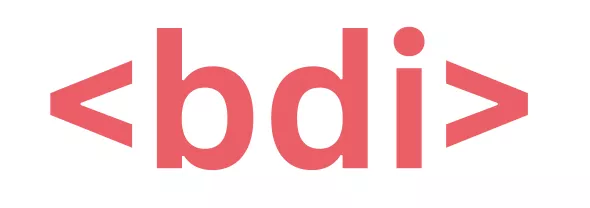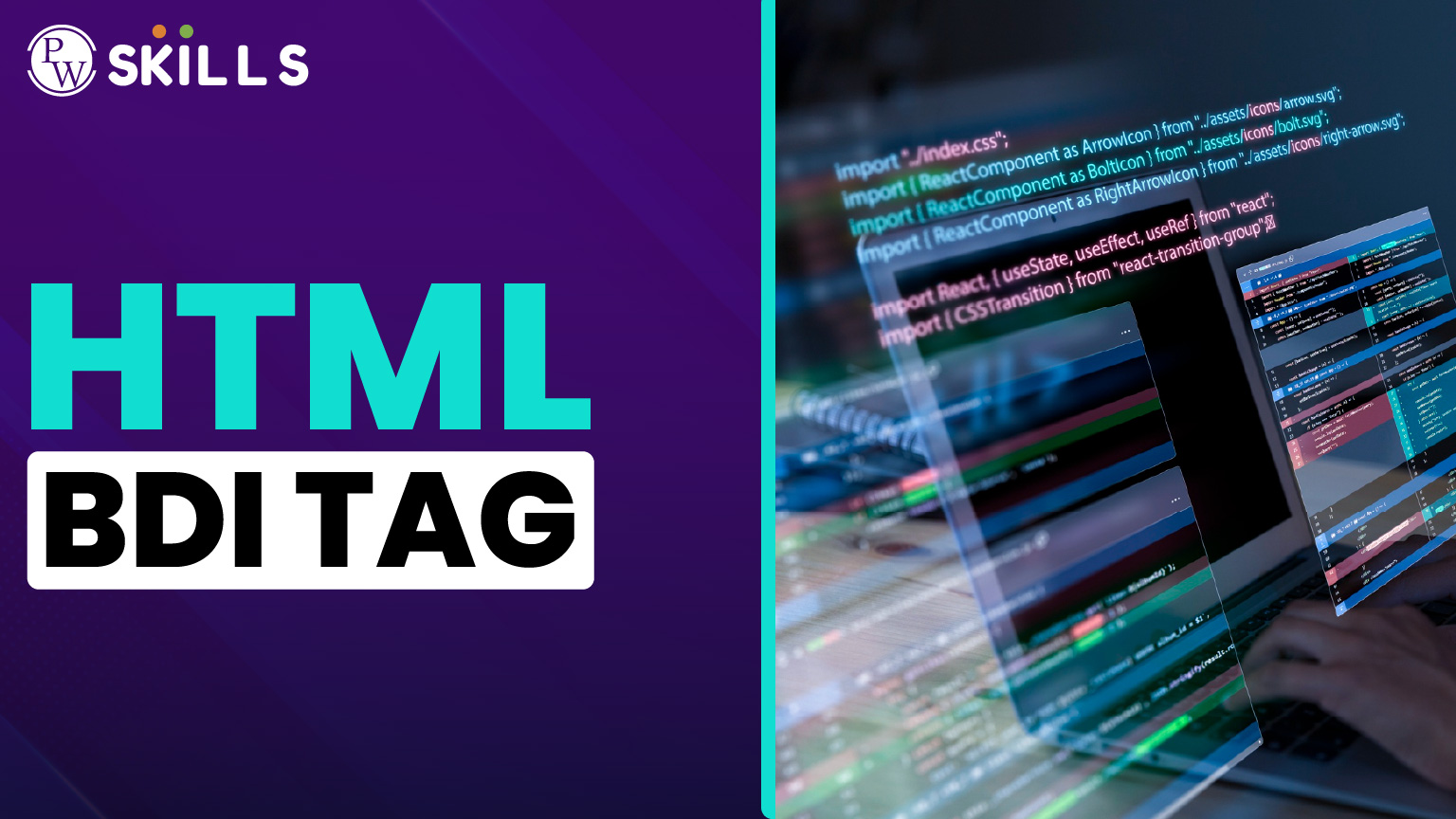Many times, there are situations when you want your text to be displayed in different languages. For example, when you build a website, there are certain points where you want to add text in multiple languages, like English mixed with Arabic or any other language. But the main problem is that these languages are written in different directions.
For example:
- English is written left to right (LTR)
- Arabic is written right to left (RTL).
So, when you combine them and add a section with both of these languages, the problem of direction arises. This can make the text look messy or unclear. This is where the HTML <bdi> tag is used.
In this blog, we will discuss the HTML <bdi> tag in detail with its examples, how and when to use the <bdi> tag, along with some of the other tags used in HTML, like <bdo>, <abbr>, and the <blockquote> tag.
What Is The HTML bdi Tag?
The <bdi> tag stands for Bi Directional Isolation. Does it sound very overwhelming? Well, don’t worry, it has a simple meaning which is used for a simple purpose. It basically prevents the direction of the text so it doesn’t get mixed up with the rest of the content.

If you want to add text that is written in two different languages, especially when the directions of those two languages are different (LTR and RTL), then the <bdi> tag ensures that the text is displayed properly and clearly without creating a mess.
Read More: HTML applet tag: Is Applet Tag No Longer Supported On HTML5
Key Highlights of the HTML bdi Tag
Some of the key points of the HTML <bdi> tag are mentioned below. Check them out.
- The HTML <bdi> tag helps to show the text in a clear way, especially when you don’t know which direction the text will be written in.
- It isolates or helps to keep the text separate so it doesn’t get mixed up with other text written in different directions.
- Also, it works with the browser system that handles different text directions automatically.
- The HTML <bdi> tag is supported by all modern web browsers, including Chrome, Mozilla Firefox, Opera Mini, except Safari.
The HTML bdi Tag Full Form
The full form of the HTML bdi Tag is the Hyper Text Markup Language bi-directional isolation element. This tag is used when different texts have different starting points.

In a different language, the starting point of texts is different, and the overall objective of the HTML bdi tag is to prevent mixing of these words, which might disrupt the meaning and actual intent of the phrase.
Read More: HTML DOCTYPE Declaration: Major Highlights For Document Type Declaration 2025
HTML bdi Tag Syntax
Now we know that the HTML <bdi> tag is used to isolate or separate the text that has different writing directions. It starts with the opening <bdi> tag and ends with the closing </bdi> tag. Check below for understanding it better understanding.
| <bdi> Text that needs isolation </bdi> |
The text written inside the <bdi> tag stays separate from the surrounding text. This ensures that the direction of one text does not impact the direction or visibility of the rest of the content on the webpage.
HTML bdi Tag Example
Let us understand the HTML <bdi> tag better with the help of a simple example. Have a look below.
| <p>User Name: <bdi>مرحبا123</bdi> joined the chat.</p> |
In the above code, the text مرحبا123 is a combination of numbers with Arabic language. So, the <bdi> tag will make sure that the text is displayed correctly without affecting the layout of the sentence. The <bdi> tag actually helps keep everything neat and readable, especially when you use more than one language and the direction of writing the languages is different.
How To Use The HTML bdi Tag?
Using the <bdi> tag is very easy. As we discussed the syntax and example, you must have got a basic idea of how the <bdi> tag is used.
Basically, you just have to add the text that you want to be isolated inside the <bdi> and </bdi> tags.
Start with the <bdi> tag, then add the text that is in different languages (different writing directions, RTL and LTR), then close it within the </bdi> tag.
When to Use the HTML bdi Tag?
You first need the HTML <bdi> tag in the following cases.
- When you have comments or chats from international users, it might be in different languages.
- When your text is in another language whose writing direction is different.
- If your content has special characters or numbers.
Some of the most common uses of the HTML <bdi> tag are mentioned below. Check them out.
- Usernames
- Social media comments from international users
- E-commerce reviews
- Forms (where people have to enter their names)
Read More: HTML Vs. HTML5 In Web Development
HTML bdi Tags Vs bdo Tags
Check the major difference between the HTML bdi tags and bdo tags.
| HTML <bdi> tag | HTML <bdo> tag |
| The bdi tag stands for bidirectional isolate | The <bdo> tag in HTML stands for bidirectional override i,e. ltr (left to right) and rtl (right to left). |
| The <bdi> tag is opened with <bdi> tag and ends with </bdi> tag. | The <bdo> tag begins with the <bdo> tag and ends with the </bdo> tag. |
| It isolates a part of the text that might have a different text direction. | It is used to override the current text direction and can be used to force text in a specific direction. |
| It has no specific attribute | It uses dir including rtl and ltr attributes. |
| When we use the <bdi> tag, it automatically fetches the right direction of the phrase. | You have to specify the text direction when using the <bdo> tag in HTML. |
| When you just want to insert user-generated text, with a different language, the <bdi> tag does things for you. | When you want to complete direction control over the text elements, you can use the <bdo> tag. |
Other Commonly Used HTML Tags
Apart from the HTML <bdi> tag, there are various other HTML tags that are used for different purposes. Let’s have a look at some of the other HTML tags and their purpose.
1. bdo Tag in HTML
The <bdo> tag in HTML stands for Bi Directional Override. The name is quite similar to the <bdi> tag, but the purpose they are used for is different. People often get confused between the <bdi> tag and the <bdo> tag, but the <bdo> tag forces the text direction even if it’s wrong.
Let us understand it better with the help of an example.
| <bdo dir=”rtl”>Hello World</bdo> |
In the above case, the text “Hello World” will be shown from right to left. Although English is normally written in LTR, because we used the <bdo> tag and mentioned the direction as RTL, the text will be displayed in right to left (RTL) direction.
2. abbr Tag in HTML
The <abbr> tag in HTML is used when you write short forms of longer terms. It displays the full form when you hover on it. Earlier, the <acronym> tag was used for the same, but now it has been replaced with the <abbr> tag because the <abbr> tag handles acronyms as well as abbreviations.
| <abbr title=”Physics Wallah”>PW</abbr> |
When you hover on PW, you’ll see Physics Wallah.
3. blockquote Tag in HTML
The <blockquote> tag in HTML is used when you want to add a quote from some other source.
| <blockquote>”Quote”</blockquote> |
HTML bdi tag FAQs
Q1. What is bdi Tag in HTML?
Ans: The Tag in HTML is used to separate the piece of text that is written in different languages which have different writing directions (LTR to RTL). For example, it is used when you wish to add a combination text of English and Arabic. English is written Left to Right, whereas Arabic is written Left to Right.
Q2. What is the difference between bdi and bdo tag in HTML?
Ans: The and <bdo have a similar name but are used for different purposes.
1. tag is used to keep the text with different directions separate.
2. <bdo forces the text direction that you've chosen (LTR or RTL).
Q3. Is bdi a self closing tag?
Ans: No. is not a self closing tag. Make sure to use both the opening () and the closing () tag.
Q4. What does and mean in HTML?
Ans: It simply means when one paragraph ends and a new paragraph begins.
</p refers to the closing of the previous paragraph.
<p refers to the starting of a new paragraph.

